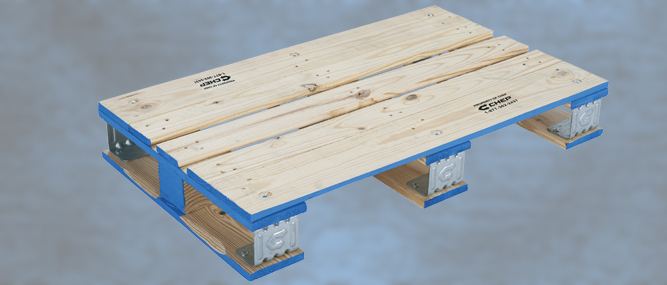The first time I ordered half-pallets, almost 20 years ago, I was trying to answer the question: how do we stop our people from cutting our $40 dollar pallets in half? It turns out that half-pallets worked perfectly for bedding plant displays at retail stores, especially ones that had chainsaws in the hands of trigger-happy store clerks. As the disfigured pallet casualties gradually trickled back to the distribution center, I convinced my boss it would be prudent to order new half-pallets for our chainsaw-inclined retail brethren rather than to suffer the continued death by dismemberment of our pallet fleet.
Half Pallets Are a Double Threat
Fast forward to today, and retail display remains a key component of the half-pallet market as it continues to grow. The exciting thing about the half-pallet is that like the wood-grain RPC, it is a double threat. It can not only help reduce costs, but it can also aid in boosting revenue. As a CHEP spokesperson told me this week, “Customer feedback shows that CHEP’s half-pallet is an effective platform for increasing sales and reducing labor costs. CHEP customers are seeing an increase in the sales of promotional items and other products displayed on half-pallets in high-traffic areas of the store. In addition, the half-pallet has shown an ability to reduce labor costs, out-of-stocks and product replenishment time.”
To take a step back, a half-pallet is predictably one that is one-half the footprint of the normal footprint. In Europe, the EPAL half measures 800×600 mm. In North America, the common half-pallet sizes are 48×20" and 40×24". Early supporters seemed to favor the 48×20.” It made for a better end-aisle display in the supermarket, while others liked the 40×24" for general floor displays, as well as for the potential of placing loaded pallets into aisle positions under aisle shelving, as is common in Europe. The now defunct CPC half-pallet was 48×20" as is the CHEP Canada half and more recently, the PECO Canadian half. The CHEP US half, introduced in 2014, is 40×24" similar in size to the EPAL half-pallet (1200×400 mm), also launched in 2014. It should be noted that CHEP had a bank of international experience on its side when it introduced its U.S. half-pallet design. At the time, it was already shipping over 100 million half-pallets per year worldwide.
There is a fundamental inefficiency when it comes to the half-pallet – it only can carry half as much merchandise as a full pallet, and in this regard, is only 50% efficient. That being said, there are some important advantages to the half-pallet in targeted applications.
The half-pallet is a good fit for retail floor displays, which drive increased sales. They do not require as much inventory as a full pallet, so they make sense for the unit load shipment of second tier items that might not warrant a full pallet display in terms of sales volume. Also, they do not take up as much room, so more displays are possible. Whether displayed on the floor or in-aisle, they eliminate almost all touch labor involved in stocking shelves.
And as displayer shipments have become more popular, the frustration of getting rid of various expendable half-pallets and associated display materials has grown. The pooled half-pallet provides an alternative to this problem. Another benefit for convenience stores, half-pallets are more easily navigated through tight spaces, as long as pallet jacks are compatible with the smaller footprint.
Half-Pallets Grow in Popularity for Non-Retail Applications
While a lot of half-pallet growth has been associated with retail, there are other opportunities as well. For unit loads that do not require a full pallet, a half-pallet can provide important benefits in terms of avoiding pallet overhang and associated cube loss, along with eliminating product damage associated with a poor pallet fit. Another advantage, half-pallets can be used to ship product and fill voids on the trailers that are too small to accommodate full pallets.
Litco International is one example of a company which offers a 40×24" half-pallet in non-retail applications. Its presswood pallet customers are mainly used in the general manufacturing space, and it has enjoyed steady growth in recent years. One customer, Lincoln Electric, uses the Litco half-pallet to ship arc welding equipment.
Gary Sharon, vice president and managing partner of Litco, reports that his company has enjoyed a steady growth in half-pallets, although little of it is related to retail. Litco presswood pallets offer additional benefits in terms of being ISPM-15 exempt. The Litco design is also nestable, which provides additional savings in terms of optimizing empty pallet delivery and minimizing on-site pallet storage requirements.
Is the Glass Half Full?
As the use of half-pallet retail displayers grows for floor, front-of-store and in-aisle applications, it seems likely that half-pallet usage and pooling will continue to expand. At the -same time, non-retail applications are enjoying the benefits of having a pallet that is a better fit with some merchandise being shipped. While the growth of the half-pallet market is unlikely to knock anyone off of their feet, it is an example of a niche application that is being more effectively served by a maturing and increasingly comprehensive pallet industry – one that is providing pallet users with more overall value in the process.




